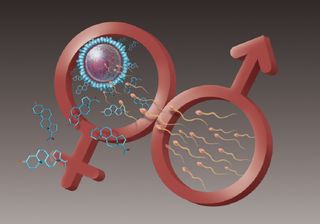How Long Does It Take For A Sperm To Reach An Egg
Wiggle Room: Female Hormone Helps Sperm Come across Egg

The female hormone progesterone kicks sperm into overdrive and so they can make a fast beeline for the egg. At present scientists take figured out how: The hormone links up with a specialized protein that signals the sperm'due south tail to jerk dorsum and forth, helping propel the little guy to its target.
"To fertilize the egg, it [sperm] needs to penetrate the protective layers of the eggs," said study researcher Polina Lishko, of the University of California in San Francisco. "For this, it needs to movement back and forth."
When progesterone binds the receptor referred to as catsper, it opens a channel in the membrane, sending a moving ridge of calcium spiking downwards the sperm body, which causes this dorsum-and-forth fluctuant of its tail.
The research is outlined this calendar week by Lishko's team in the journal Nature and in a second study, from a team led by U. Benjamin Kaupp at the Center for Avant-garde European Studies and Research in Germany.
Catsper's calcium affinity
"It'south been known for more than xx years that progesterone is a very significant stimulant of sperm's various functions," said Stephen Publicover, of the schoolhouse of biosciences at the University of Birmingham in the Great britain, who wrote an accompanying "News and Views" article in the journal issue.
Until now, notwithstanding, scientists didn't know how the hormone and catsper interacted. The team looked at homo sperm cells, measuring calcium flux that causes the tail motility. Their experiments showed that progesterone's interaction with catsper was critical to causing the wave of calcium, an integral part of getting sperm through the cells surrounding the egg. Past research had shown for mice, all that was needed was a change in pH, or acidity level. Humans demand both pH changes and progesterone, it appears.
"Progesterone doesn't actuate mouse sperm cells — it's very specific to humans," Lishko told LiveScience. "When you lot study human fertility, you lot have to written report it on the homo sperm cells."
The researchers constitute that in human cells, progesterone opens catsper channels in the sperm and sends a wave of calcium to hyperactivate the tail. The effect: Big swings of the sperm's tail, which are integral to getting it through the cells surrounding the egg. If it can't get through, the sperm never reaches the egg and tin can't fertilize information technology. Both humans and mice with nonfunctional catsper are infertile.
Contraceptive candidate
Because the catsper protein is just expressed in sperm cells, it's a perfect candidate to target with drugs, the researchers say. A drug that could incapacitate this channel or cake it from binding with progesterone would cease the sperm from hyperactivating, and it couldn't suspension through to the egg to fertilize information technology.
"Catsper channel is a great target for developing new contraceptives, considering information technology's expressed only on the sperm cells," Lishko said. (That means men and women could have it without impacting other reproductive functions or having the side furnishings of hormone-based drugs, like the pill.)
The research could also dig upwardly other proteins involved in the sperm-to-egg procedure, leading to nonhormonal contraceptive drugs, Publicover said.
Lishko's team is at present working to make up one's mind where the progesterone binds on the channel, and they hope to written report patients with deficiencies in the catsper aqueduct, to run into how progesterone affects their sperm.
You lot tin follow LiveScience staff writer Jennifer Welsh on Twitter @ microbelover .
Source: https://www.livescience.com/13264-sperm-activation-progesterone-hormone-110316.html
Posted by: tavaresthemarly.blogspot.com

0 Response to "How Long Does It Take For A Sperm To Reach An Egg"
Post a Comment